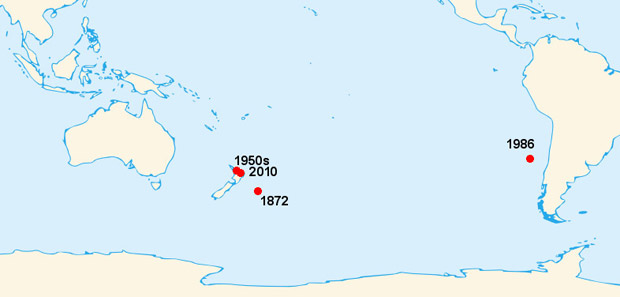We have also in the past reported in Significance on how many big new sea-creatures probably remain to be discovered in the oceans. You can attempt to work it out from the number of people who are looking, the number of years they have been looking, and the rate of past discoveries – which was fast in the early years of Victorian scientific sea-voyages – from Darwin in the Beagle, via HMS Challenger’s great oceanographic expedition of 1872-76 and onwards – and then tailed off through the 20th century as more and more species were identified leaving fewer and fewer to be ‘discovered’ and described. Perhaps the last really famous one was the Coelacanth, known from the fossils but discovered as a living species in 1938. The Colossal Squid – even bigger than the Giant Squid, and living even deeper – was discovered in 1928 from bits of it in the stomach of a whale, but a specimen was only caught in 1981.
Andrew Solow and Derek Tittensor, who were the statisticians for the great (and largest-ever) Marine Census which lasted ten years and ended in 2010, wrote of such matters for us in the December 2010 issue of Significance magazine. Their conclusion was that there are probably somewhere between 10 and 47 large species of sea-creatures still waiting to be discovered. The Spade-toothed whale might seem to be one of them.
A big new species of whale surely gladdens the heart. Nevertheless the whales story is a sad one, and a little complicated. As with the coelacanth, its was non-living evidence that first showed up: in the whales case, part of a jaw was washed up on a beach on an island off New Zealand and was picked up by a collector by the name of Henry Travers. That was back in 1872. The first scientist who described it thought it was from a strap-toothed whale. The second, John Gray by name, thought it was a separate species, and gave it the Latin name Mesoplodon traversii, after its finder; but he was on his own, and the jaw was officially ascribed to a strap-tooth.

Localities and dates of the known Mesoplodon traversii (=Mesoplodon bahamondi) specimens.
A skull-cap was washed up on another New Zealand island in 1950; that, too, was ascribed to another species, the ginko-toothed beaked whale; and another off Chile in 1986. This time it was thought to come from a Bahamonde’s beaked whale (All the whale species we are talking about are beaked whales, of which there are many, and, as you might have gathered, all much alike.)
In 2010 two whales, a mother and her calf, beached themselves in New Zealand and died . And – guess what – again they were mis-identified. Only when DNA samples were taken, and found to be new but to match samples from the previous fragments, was it realised that these two were the only complete specimens of their species ever seen. John Gray had been right after all. The spade-toothed whale is a species of its own, and exists.
So, voila: there is now one more known species of whale in the world than we thought. How long it will continue to remain in the world is another matter: see ‘Whale Science and How (not) to use it’ in Significance magazine for the complicated business of how you count whales, and how you try to work out how many of them people like the Japanese can catch without sending them to join the Western Black rhino in extinction.




